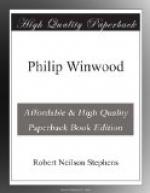cause, all their American real estate being confiscated
by the New York assembly. The mansion became
in time the residence of that remarkable woman who,
from a barefoot girl in Providence, R.I., had grown
up to be the wife of a Frenchman named Jumel; and
to be the object of much admiration, and the subject
of some scandal. In her widowhood she received
under this roof Aaron Burr, after his duel with Hamilton
(whose neighbouring country-house still exists, in
Convent Avenue), and under this roof she and Burr—both
in their old age—were united in marriage.
I imagine that some of the ghosts that haunt this
mansion, if they might be got in a corner, would yield
their interviewers a quaint reminiscence or two.
The grounds appertaining to the house have been sadly
diminished by the opening of new streets; yet it is
still a fine, striking landmark, perched to be seen
afar, as from the railroad trains that follow the
East bank of the Harlem, or, better, from West 155th
Street at and about its junction with St. Nicholas
Place and the Speedway. At the time when I left
New York for a temporary residence in the Old World,
there was talk of moving the house to a less commanding,
but still eminent, height that crowns the bluff rising
from the Speedway: the owner was compelled, it
was said, to avail himself of the increased value
of the land whereon it stood. ’Tis some
pity if this has been, or has to be, done; but nothing
to the pity if the mansion had to be pulled down.
Apart from all associations and historical interest,
this imposing specimen of our Colonial domestic architecture,
so simple and reposeful an edifice amidst a world
of flat buildings, and of gew-gaw houses built for
sale on the instalment plan to the ubiquitous Mr. and
Mrs. Veneering, is a precious relief, nay an untiring
delight, to the eye.
NOTE 5 (Page 202).
During this Winter (1779-80) the Continental army
was in two main divisions. The one with which
Washington made his headquarters was hutted on the
heights about Morristown, N.J. The other, under
General Heath, was stationed in the highlands of the
Hudson. Intermediate territory, of course, was
more or less thoroughly guarded by detached posts,
militia, and various forces regular and irregular.
The most of the cavalry was quartered in Connecticut;
but Winwood’s troop, as our narrative shows,
was established near Washington’s headquarters.
This was a memorably cold Winter, and as severe upon
the patriots as the more famous Winter (1777-78) at
Valley Forge. About the latter part of January
the Hudson was frozen over, almost to its mouth.
NOTE 6 (Page 269).
Long before I fell upon Lieut. Russell’s
narrative, a detailed account of a British attempt
to capture Washington, by a bold night dash upon his
quarters at Morristown, had caught my eyes from the
pages of the old “New Jersey Historical Collections.”
Washington was not the only object of such designs
during the War of Independence. One was planned
for the seizure of Governor Livingstone at his home
in Elizabeth, N.J.; but, much to Sir Henry Clinton’s
disappointment, that influential and witty champion
of independence was not at home when the surprise
party called.




